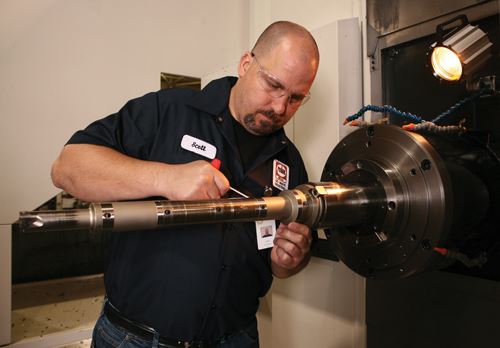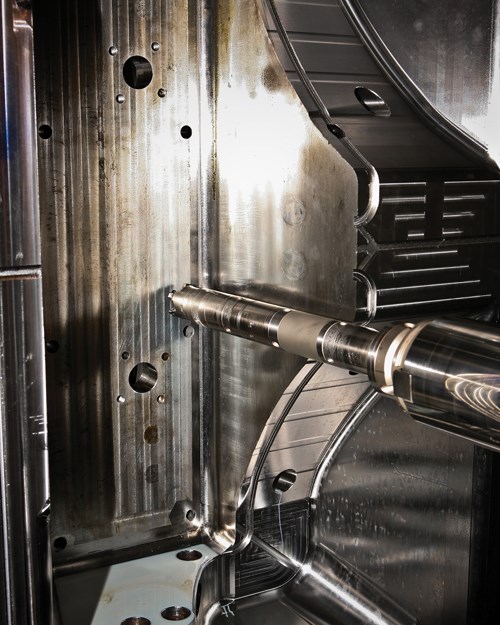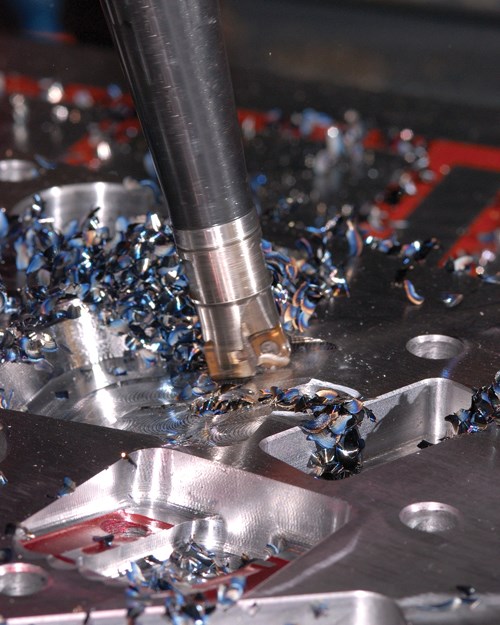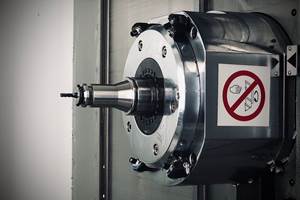Stiff offshore competition isn’t the only challenge facing North American mold shops. Both Redoe Mold Ltd. (RML) and Chicago Mold Engineering (CME), for example, are seeing larger automotive headlight molds with deeper cavities that require long-reach machining. Meanwhile, Precision Mold Base Corporation (PMBC) contends with the difficulties of cutting into layers of different metals with vastly different machining characteristics.
The good news is that cutting tools designed specifically for high-feed machining strategies can help moldmakers like these overcome such obstacles and boost competitiveness. For example, RML uses a Form-MasterV cutter from Ingersoll Cutting Tools (Rockford, Illinois) to machine deep cavities in half the time as a previous setup. CME has realized similar benefits with another high-feed tool from the same supplier, the
Hi-FeedMini. Finally, PMBC’s switch to the Form-Master+ button-type face mill, also from Ingersoll, has improved tool life to the point that the company can machine bi-metal mold base “sandwiches” completely unattended.
High-feed milling strategies are characterized by lighter, faster passes that increase metal-removal rates and improve throughput. “Volumetrically, the metal comes off faster, while
cutting forces, especially lateral cutting forces, are reduced,” says Bill Fiorenza, die and mold product manager at Ingersoll Cutting Tools.
Typically, high-feed tooling has low lead angles (10 to 20 degrees) and triangular inserts, he explains. Such geometry reduces lateral cutting forces, a key concern for long-reach milling operations like those conducted at CME and RML. A rigid machine platform is equally important for such work, Mr. Fiorenza says. Lacking either condition can result in reduced accuracy, chatter, overloaded spindle bearings, and fractured cutting edges.
Sometimes, switching to high-feed cutters and standard extensions can be enough if the machine itself is rigid. That was the case at CME’s St. Charles, Illinois facility. “We have very new, very rigid machinery, including an FTP mill, and we keep it in tip-top condition,” says CME’s CNC coordinator Bill Kloskowski. “Otherwise we couldn’t run as fast as we do.”
With a rigid platform already in place, CME can take full advantage of the Ingersoll Hi-FeedMini’s high-feed geometry and additional flutes. Together, these features enabled increasing feed rates from 80 to 200 ipm for semi-roughing deep cavities in hardened P20 steel. As a result, a cavity that once took six hours can be finished in only two and a half hours.
At its facility in Windsor, Ontario, RML faced the same problem as CME. “Mold cavities today are 5 to 8 inches deeper than what they were just five years ago,” explains Jay Noble, lead machinist. “The main drivers are the automotive styling trend toward longer runouts in exterior light assemblies and the push for lower part counts.” These cavities range from 15 to 22 inches deep, typically in hardened stock. For the deepest work, RML uses a new Toshiba boring mill with an Ingersoll Form-MasterV. That tool mounts on an Inno-Fit shank extension from the same supplier.
Along with the machine itself, the design of the shank extension helps ensure rigidity. Unlike models that use a slide coupling system between butting surfaces, the Inno-Fit features a self-centering, three-point coupling design. It also offers a large contact area at the mating surfaces and is constructed from wear-resistant material. As for the cutter, it uses inserts with high feed, positive-rake geometry that converts most lateral cutting forces to axial forces. This helps keep the tool on-center. In fact, the shop routinely meets tolerances of ±0.001 inch on both dimension and runout throughout the depth of any given cavity, Mr. Noble says.
Compared to a previous setup, this configuration enables the company to machine most cavities in half the time. It can also machine 8:1 aspect holes four to five times faster. Insert edges last 20 percent longer than the previous tool, despite increasing feed rates from 50 ipm to between 300 and 400 ipm. “We used to have to slow down the deeper we went, but not anymore,” Mr. Noble says. “Even at these rates, the sudden insert fractures that can haunt long-reach work are a thing of the past.”
At PMBC’s facility in Tempe, Arizona, high feed milling helps with a completely different problem: milling the metal “sandwiches” that go into virtually every mold base. These layered assembly components consist of 420 and 4140 steel, materials with very different machining characteristics. “The stainless is gummy and long chipping; the 2140 is harder but short chipping,” explains Romney D’ Antuono, PMBC foreman.
Continuing with the sandwich analogy, he likens rough-milling around the edges of these components to cutting the crust off of a slice of bread. However, the edges of the material don’t always line up, and slots and grooves often create interrupted cuts and varied cutting depths. PMBC originally performed this work with conventional, zero-rake button cutters with five inserts. At 25 ipm and a cutting depth of 0.06 inch, the process was slow. Moreover, inserts would often break suddenly in mid-cut. In fact, inserts failed so often and unpredictably that the term “average edge life” became meaningless, Mr. D’Antuono says.
Switching to a high-feed Ingersoll Form-Master+ button-type face mill brought immediate improvements. “This was the most abusive milling operation in the shop, but now, it purrs along like a pussycat,” Mr. D’Antuono says.This tool can run at 55 ipm, improving material removal rate by 7 to 1 and throughput by 2 ½ to 1, he notes. Inserts last four to five times longer, and catastrophic failure is just a memory, he says. Additionally, slowing down by only 10 percent enables the company to run the operation
lights-out. Previously, that was out of the question without decreasing parameters until unattended machining would no longer be profitable.
Mr. D’Antuono attributes these gains to the geometry of the Form-Master+ face mill. Presenting the cutting edge at a positive angle cleaves the metal rather than scraping it off. “You can tell the difference just by listening,” he says.












































.png;maxWidth=300;quality=90)












